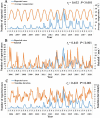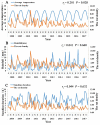Epidemiology of tsutsugamushi disease and its relationship with meteorological factors in Xiamen city, China
- PMID: 33057334
- PMCID: PMC7591240
- DOI: 10.1371/journal.pntd.0008772
Epidemiology of tsutsugamushi disease and its relationship with meteorological factors in Xiamen city, China
Abstract
Tsutsugamushi disease (TD) is an acute infectious disease caused by Orientia tsutsugamushi. This study aimed to analyze the epidemiological features of TD, investigate chigger mites and their hosts, and investigate the meteorological factors affecting TD incidence and the host of O. tsutsugamushi in Xiamen city, China. Data on reported TD cases were collected from 2006 to 2018. Spearman's correlation test were used for identifying the relationship between meteorological factors and TD incidence and whether meteorological factors affect the host of O. tsutsugamushi. The incidence of reported TD increased gradually from 2006, reached a peak of 4.59 per 100,000 persons in 2014, and then decreased gradually. The TD incidence was seasonal, with epidemic periods occurred mainly in summer and autumn. Patients aged 40-60 years had the highest proportion of cases, accounting for 44.44% of the total cases. Farmers had the largest number of cases among all occupational groups. Rattus Norvegicus was the most common host, accounting for the largest proportion of rats (73.00%), and the highest rat density was observed in March and October every year. There were significant positive correlations between the number of reported cases and average temperature, sunshine duration, and rainfall as well as between rat density and average temperature. On phylogenetic analysis, 7 sequences of hosts and human TD cases obtained from health records demonstrated the highest similarities to the Kato, Karp, and Gilliam strains. No correlations were observed between rat density, and sunshine duration and rainfall. The transmission of TD in Xiamen city, China, was seasonal, and its incidence was affected by several meteorological factors including average temperature, sunshine duration, and rainfall. However, the host of O. tsutsugamushi was only affected by average temperature.
Conflict of interest statement
The authors have declared that no competing interests exist.
Figures










Similar articles
-
Epidemiological studies on host animals of scrub typhus of the autumn-winter type in Shandong Province, China.Southeast Asian J Trop Med Public Health. 2003 Dec;34(4):826-30. Southeast Asian J Trop Med Public Health. 2003. PMID: 15115095
-
[Clinical manifestations and epidemic factors of autumn-winter type scrub typhus in children from northern new endemic area].Zhonghua Er Ke Za Zhi. 2008 Feb;46(2):128-31. Zhonghua Er Ke Za Zhi. 2008. PMID: 19099688 Chinese.
-
[Study of epidemic area on Tsutsugamushi disease in Taizhou from 2013 to 2014].Zhonghua Yu Fang Yi Xue Za Zhi. 2017 Mar 6;51(3):252-256. doi: 10.3760/cma.j.issn.0253-9624.2017.03.012. Zhonghua Yu Fang Yi Xue Za Zhi. 2017. PMID: 28260341 Chinese.
-
The Prevalence of Rodents Orientia tsutsugamushi in China During Two Decades: A Systematic Review and Meta-Analysis.Vector Borne Zoonotic Dis. 2023 Dec;23(12):619-633. doi: 10.1089/vbz.2023.0057. Epub 2023 Aug 25. Vector Borne Zoonotic Dis. 2023. PMID: 37625029
-
[Recent advances in molecular epidemiology of Orientia tsutsugamushi in China].Zhonghua Liu Xing Bing Xue Za Zhi. 2014 Jan;35(1):88-92. Zhonghua Liu Xing Bing Xue Za Zhi. 2014. PMID: 24685046 Review. Chinese. No abstract available.
Cited by
-
Containing the Transmission of COVID-19: A Modeling Study in 160 Countries.Front Med (Lausanne). 2021 Aug 18;8:701836. doi: 10.3389/fmed.2021.701836. eCollection 2021. Front Med (Lausanne). 2021. PMID: 34485337 Free PMC article.
-
Co-effects of global climatic dynamics and local climatic factors on scrub typhus in mainland China based on a nine-year time-frequency analysis.One Health. 2022 Oct 13;15:100446. doi: 10.1016/j.onehlt.2022.100446. eCollection 2022 Dec. One Health. 2022. PMID: 36277104 Free PMC article.
-
Epidemiological characteristics and influencing factors of scrub typhus in Jiangxi Province.Parasit Vectors. 2025 Jul 5;18(1):260. doi: 10.1186/s13071-025-06908-7. Parasit Vectors. 2025. PMID: 40618171 Free PMC article.
-
Clinical treatment of patients with scrub typhus-induced liver injury and intracranial infection.J Int Med Res. 2023 Nov;51(11):3000605231214503. doi: 10.1177/03000605231214503. J Int Med Res. 2023. PMID: 38008898 Free PMC article.
-
Spatiotemporal epidemiology and risk factors of scrub typhus in Hainan Province, China, 2011-2020.One Health. 2023 Oct 12;17:100645. doi: 10.1016/j.onehlt.2023.100645. eCollection 2023 Dec. One Health. 2023. PMID: 38024283 Free PMC article.
References
-
- Inoue K, Kabeya H, Fujita H, Makino T, Asano M, Inoue S, et al. Serological survey of five zoonoses, scrub typhus, Japanese spotted fever, tularemia, Lyme disease, and Q fever, in feral raccoons (Procyon lotor) in Japan. Vector Borne and Zoonotic Diseases (Larchmont, NY). 2011;11: 15–19. - PubMed
-
- Olson JG. Forecasting the onset of a scrub typhus epidemic in the Pescadores Islands of Taiwan using daily maximum temperatures. Tropical and Geographical Medicine.1979;31:519–524. - PubMed
Publication types
MeSH terms
LinkOut - more resources
Full Text Sources

